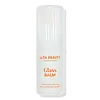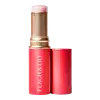What's inside
What's inside
 Key Ingredients
Key Ingredients

 Benefits
Benefits

 Concerns
Concerns

 Ingredients Side-by-side
Ingredients Side-by-side

Octyldodecanol
EmollientDiisostearyl Malate
EmollientPolybutene
Synthetic Wax
AbrasiveSynthetic Fluorphlogopite
Microcrystalline Wax
Emulsion StabilisingVp/Eicosene Copolymer
Disteardimonium Hectorite
StabilisingSilica
AbrasiveSorbitan Sesquioleate
EmulsifyingPhenoxyethanol
PreservativeGlyceryl Caprylate
EmollientEthylhexylglycerin
Skin ConditioningWater
Skin ConditioningPentaerythrityl Tetraisostearate
EmollientAscorbyl Glucoside
AntioxidantNiacinamide
SmoothingCaprylic/Capric Triglyceride
MaskingPropylene Carbonate
SolventStearalkonium Hectorite
Gel FormingTocopherol
Antioxidant1,2-Hexanediol
Skin ConditioningSodium Hyaluronate
HumectantPalmitoyl Tripeptide-1
Skin ConditioningMica
Cosmetic ColorantCI 77891
Cosmetic ColorantOctyldodecanol, Diisostearyl Malate, Polybutene, Synthetic Wax, Synthetic Fluorphlogopite, Microcrystalline Wax, Vp/Eicosene Copolymer, Disteardimonium Hectorite, Silica, Sorbitan Sesquioleate, Phenoxyethanol, Glyceryl Caprylate, Ethylhexylglycerin, Water, Pentaerythrityl Tetraisostearate, Ascorbyl Glucoside, Niacinamide, Caprylic/Capric Triglyceride, Propylene Carbonate, Stearalkonium Hectorite, Tocopherol, 1,2-Hexanediol, Sodium Hyaluronate, Palmitoyl Tripeptide-1, Mica, CI 77891
Diisostearyl Malate
EmollientOctyldodecanol
EmollientPolyisobutene
Synthetic Wax
AbrasiveCopernicia Cerifera Wax
Glycerin
HumectantCamellia Japonica Seed Oil
EmollientButyrospermum Parkii Butter
Skin ConditioningGlyceryl Glucoside
HumectantSqualane
EmollientTremella Fuciformis Polysaccharide
Emulsion StabilisingAlpha-Glucan Oligosaccharide
CleansingGlucose
HumectantCollagen Extract
Skin ConditioningPanax Ginseng Root Extract
EmollientHordeum Distichon Extract
Skin ProtectingHouttuynia Cordata Extract
Skin ConditioningPrunus Persica Leaf Extract
EmollientBifida Ferment Filtrate
Skin ConditioningVitis Vinifera Fruit Extract
Skin ConditioningArtemisia Vulgaris Extract
Skin ConditioningPanthenol
Skin ConditioningTremella Fuciformis Extract
HumectantHydrolyzed Sodium Hyaluronate
Skin ConditioningSodium Hyaluronate
HumectantHydrolyzed Hyaluronic Acid
HumectantHyaluronic Acid
HumectantSodium Hyaluronate Crosspolymer
HumectantPalmitoyl Tripeptide-1
Skin ConditioningAcetyl Hexapeptide-8
HumectantTripeptide-1
Skin ConditioningCopper Tripeptide-1
Skin ConditioningAcetyl Tetrapeptide-5
HumectantPalmitoyl Pentapeptide-4
Skin ConditioningHexapeptide-9
Skin ConditioningNonapeptide-1
Skin ConditioningDipeptide-2
Skin ConditioningLecithin
EmollientRosa Canina Seed Extract
EmollientWater
Skin ConditioningHelianthus Annuus Seed Oil
EmollientAdenosine
Skin ConditioningTocopherol
AntioxidantButylene Glycol
HumectantHibiscus Rosa-Sinensis Flower Extract
HumectantSantalum Album Extract
Cleansing1,2-Hexanediol
Skin ConditioningEthylhexylglycerin
Skin ConditioningCaprylyl Glycol
EmollientPhellodendron Amurense Bark Extract
Skin ConditioningChlorella Ferment
Skin ConditioningPolyglyceryl-10 Oleate
Skin ConditioningPentylene Glycol
Skin ConditioningMica
Cosmetic ColorantTitanium Dioxide
Cosmetic ColorantTitanium/Titanium Dioxide
Cosmetic ColorantTin Oxide
AbrasiveCI 77491
Cosmetic ColorantDiisostearyl Malate, Octyldodecanol, Polyisobutene, Synthetic Wax, Copernicia Cerifera Wax, Glycerin, Camellia Japonica Seed Oil, Butyrospermum Parkii Butter, Glyceryl Glucoside, Squalane, Tremella Fuciformis Polysaccharide, Alpha-Glucan Oligosaccharide, Glucose, Collagen Extract, Panax Ginseng Root Extract, Hordeum Distichon Extract, Houttuynia Cordata Extract, Prunus Persica Leaf Extract, Bifida Ferment Filtrate, Vitis Vinifera Fruit Extract, Artemisia Vulgaris Extract, Panthenol, Tremella Fuciformis Extract, Hydrolyzed Sodium Hyaluronate, Sodium Hyaluronate, Hydrolyzed Hyaluronic Acid, Hyaluronic Acid, Sodium Hyaluronate Crosspolymer, Palmitoyl Tripeptide-1, Acetyl Hexapeptide-8, Tripeptide-1, Copper Tripeptide-1, Acetyl Tetrapeptide-5, Palmitoyl Pentapeptide-4, Hexapeptide-9, Nonapeptide-1, Dipeptide-2, Lecithin, Rosa Canina Seed Extract, Water, Helianthus Annuus Seed Oil, Adenosine, Tocopherol, Butylene Glycol, Hibiscus Rosa-Sinensis Flower Extract, Santalum Album Extract, 1,2-Hexanediol, Ethylhexylglycerin, Caprylyl Glycol, Phellodendron Amurense Bark Extract, Chlorella Ferment, Polyglyceryl-10 Oleate, Pentylene Glycol, Mica, Titanium Dioxide, Titanium/Titanium Dioxide, Tin Oxide, CI 77491
Ingredients Explained
These ingredients are found in both products.
Ingredients higher up in an ingredient list are typically present in a larger amount.
1,2-Hexanediol is a synthetic liquid and another multi-functional powerhouse.
It is a:
- Humectant, drawing moisture into the skin
- Emollient, helping to soften skin
- Solvent, dispersing and stabilizing formulas
- Preservative booster, enhancing the antimicrobial activity of other preservatives
Diisostearyl Malate is an emollient and most often used in lip products. It comes from isostearyl alcohol, a fatty acid, and malic acid, an AHA.
As an emollient, Diisostearyl Malate helps create a thin film on your skin to trap moisture in. This helps keep your skin soft and smooth.
Ethylhexylglycerin (we can't pronounce this either) is commonly used as a preservative and skin softener. It is derived from glyceryl.
You might see Ethylhexylglycerin often paired with other preservatives such as phenoxyethanol. Ethylhexylglycerin has been found to increase the effectiveness of these other preservatives.
Mica is a naturally occurring mineral used to add shimmer and color in cosmetics. It can also help improve the texture of a product or give it an opaque, white/silver color.
Serecite is the name for very fine but ragged grains of mica.
This ingredient is often coated with metal oxides like titanium dioxide. Trace amounts of heavy metals may be found in mica, but these metals are not harmful in our personal products.
Mica has been used since prehistoric times throughout the world. Ancient Egyptian, Indian, Greek, Roman, Aztec, and Chinese civilizations have used mica.
Learn more about MicaOctyldodecanol is a fatty alcohol. It is primarily used to enhance the texture of products.
As an emulsifier, Octyldodecanol helps prevent the oils and waters from separating. It also prevents ingredients from creating foam when shaken.
Octyldodecanol is created by reducing fatty acid to an alcohol.
Due to its high molecular weight, it does not get absorbed into the skin.
Learn more about OctyldodecanolPalmitoyl Tripeptide-1 is also known as pal-GHK. It is made up of 3 amino acids and palmitic acid, a fatty acid that helps it absorb into skin more easily.
This peptide is as a signal peptide, meaning it tells the skin to produce more collagen. Collagen is the key protein that helps form the skin's structure and keep it plump, firm, and hydrated.
By boosting collagen production, this ingredient supports a stronger skin barrier and helps reduce the appearance of wrinkles.
You'll most likely see this ingredient paired with Palmitoyl Tetrapeptide-7 in the well-known Matrixyl 3000 complex. While results from in-house testing should be viewed cautiously, this peptide duo is among the most studied and widely used in modern skincare.
Due to its palmitic acid base, this ingredient may not be safe for Malassezia folliculitis.
Read more about other common types of peptides here:
Learn more about Palmitoyl Tripeptide-1Sodium Hyaluronate is hyaluronic acid's salt form. It is commonly derived from the sodium salt of hyaluronic acid.
Like hyaluronic acid, it is great at holding water and acts as a humectant. This makes it a great skin hydrating ingredient.
Sodium Hyaluronate is naturally occurring in our bodies and is mostly found in eye fluid and joints.
These are some other common types of Hyaluronic Acid:
Learn more about Sodium HyaluronateSynthetic Wax is created from fossil fuels such as natural gas. It is used to enhance texture, adjust pH, and as an occlusive.
It may also be used as an abrasive ingredient to exfoliate the skin.
Synthetic Wax may not be fungal acne safe.
Learn more about Synthetic WaxTocopherol (also known as Vitamin E) is a common antioxidant used to help protect the skin from free-radicals and strengthen the skin barrier. It's also fat soluble - this means our skin is great at absorbing it.
Vitamin E also helps keep your natural skin lipids healthy. Your lipid skin barrier naturally consists of lipids, ceramides, and fatty acids. Vitamin E offers extra protection for your skin’s lipid barrier, keeping your skin healthy and nourished.
Another benefit is a bit of UV protection. Vitamin E helps reduce the damage caused by UVB rays. (It should not replace your sunscreen). Combining it with Vitamin C can decrease sunburned cells and hyperpigmentation after UV exposure.
You might have noticed Vitamin E + C often paired together. This is because it is great at stabilizing Vitamin C. Using the two together helps increase the effectiveness of both ingredients.
There are often claims that Vitamin E can reduce/prevent scarring, but these claims haven't been confirmed by scientific research.
Learn more about TocopherolWater. It's the most common cosmetic ingredient of all. You'll usually see it at the top of ingredient lists, meaning that it makes up the largest part of the product.
So why is it so popular? Water most often acts as a solvent - this means that it helps dissolve other ingredients into the formulation.
You'll also recognize water as that liquid we all need to stay alive. If you see this, drink a glass of water. Stay hydrated!
Learn more about Water